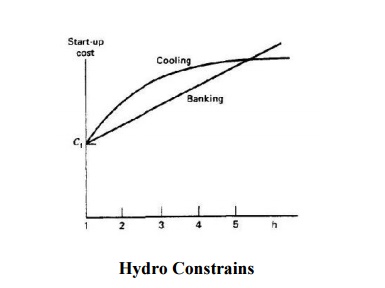Chapter: Power System Operation and Control : Commitment and Economic Dispatch
Unit Commitment - Introduction
UNIT COMMITMENT - INTRODUCTION
Ø The life style of a modern man follows regular habits and hence the present society also follows regularly repeated cycles or pattern in daily life.
Ø Therefore, the consumption of electrical energy also follows a predictable daily, weekly and seasonal pattern.
Ø There are periods of high power consumption as well as low power consumption.
Ø It is therefore possible to commit the generating units from the available capacity into service to meet the demand.
Ø The previous discussions all deal with the computational aspects for allocating load to a plant in the most economical manner.
Ø For a given combination of plants the determination of optimal combination of plants for operation at any one time is also desired for carrying out the aforesaid task.
Ø The plant commitment and unit ordering schedules extend the period of optimization from a few minutes to several hours.
Ø From daily schedules weekly patterns can be developed.
Ø Likewise, monthly, seasonal and annual schedules can be prepared taking into consideration the repetitive nature of the load demand and seasonal variations.
Ø Unit commitment schedules are thus required for economically committing the units in plants to service with the time at which individual units should be taken out from or returned to service.
1.Constraints In Unit Commitment
Ø Many constraints can be placed on the unit commitment problem. The list presented here is by no means exhaustive.
Ø Each individual power system, power pool, reliability council, and so forth, may impose different rules on the scheduling of units, depending on the generation makeup, load-curve characteristics, and such.
2. Spinning Reserve
Ø Spinning reserve is the term used to describe the total amount of generation available from all units synchronized (i.e., spinning) on the system, minus the present load and losses being supplied.
Ø Spinning reserve must be carried so that the loss of one or more units does not cause too far a drop in system frequency.
Ø Quite simply, if one unit is lost, there must be ample reserve on the other units to make up for the loss in a specified time period.
Ø Spinning reserve must be allocated to obey certain rules, usually set by regional reliability councils (in the United States) that specify how the reserve is to be allocated to various units.
Ø Typical rules specify that reserve must be a given percentage of forecasted peak demand, or that reserve must be capable of making up the loss of the most heavily loaded unit in a given period of time.
Ø Others calculate reserve requirements as a function of the probability of not having sufficient generation to meet the load.
Ø Not only must the reserve be sufficient to make up for a generation-unit failure, but the reserves must be allocated among fast-responding units and slow-responding units.
Ø This allows the automatic generation control system to restore frequency and interchange quickly in the event of a generating-unit outage.
Ø Beyond spinning reserve, the unit commitment problem may involve various classes of
“scheduled reserves” or “off-line” reserves.
Ø These include quick-start diesel or gas-turbine units as well as most hydro-units and pumped-storage hydro-units that can be brought on-line, synchronized, and brought up to full capacity quickly.
Ø As such, these units can be “counted” in the overall reserve assessment, as long as their time to come up to full capacity is taken into account.
Ø Reserves, finally, must be spread around the power system to avoid transmission system limitations (often called “bottling” of reserves) and to allow various parts of the system to run as “islands,” should they become electrically disconnected.
3. Thermal Unit Constraints
Ø Thermal units usually require a crew to operate them, especially when turned on and turned off.
Ø A thermal unit can undergo only gradual temperature changes, and this translates into a time period of some hours required to bring the unit on-line.
Ø As a result of such restrictions in the operation of a thermal plant, various constraints arise, such as:
1. Minimum up time: once the unit is running, it should not be turned off immediately
2. Minimum down time: once the unit is decommitted, there is a minimum time before it can be recommitted.
Cc = cold-start cost (MBtu)
F = fuel cost
Cf= fixed cost (includes crew expense, maintenance expenses) (in R)
α = thermal time constant for the unit
t = time (h) the unit was cooled
Start-up cost when banking = Ct x t x F+Cf
Where
Ct = cost (MBtu/h) of maintaining unit at operating temperature
Up to a certain number of hours, the cost of banking will be less than the cost of cooling, as is illustrated in Figure.
Finally, the capacity limits of thermal units may change frequently, due to maintenance or unscheduled outages of various equipment in the plant; this must also be taken.
4. Other Constraints
1. Hydro-Constraints
Ø Unit commitment cannot be completely separated from the scheduling of hydro-units.
Ø In this text, we will assume that the hydrothermal scheduling (or “coordination”) problem can be separated from the unit commitment problem.
Ø We, of course, cannot assert flatly that our treatment in this fashion will always result in an optimal solution.

2. Must Run
Ø Some units are given a must-run status during certain times of the year for reason of voltage support on the transmission network or for such purposes as supply of steam for uses outside the steam plant itself.
3. Fuel Constraints
Ø We will treat the “fuel scheduling” problem system in which some units have limited fuel, or else have constraints that require them to burn a specified amount of fuel in a given time, presents a most challenging unit commitment problem.
Related Topics